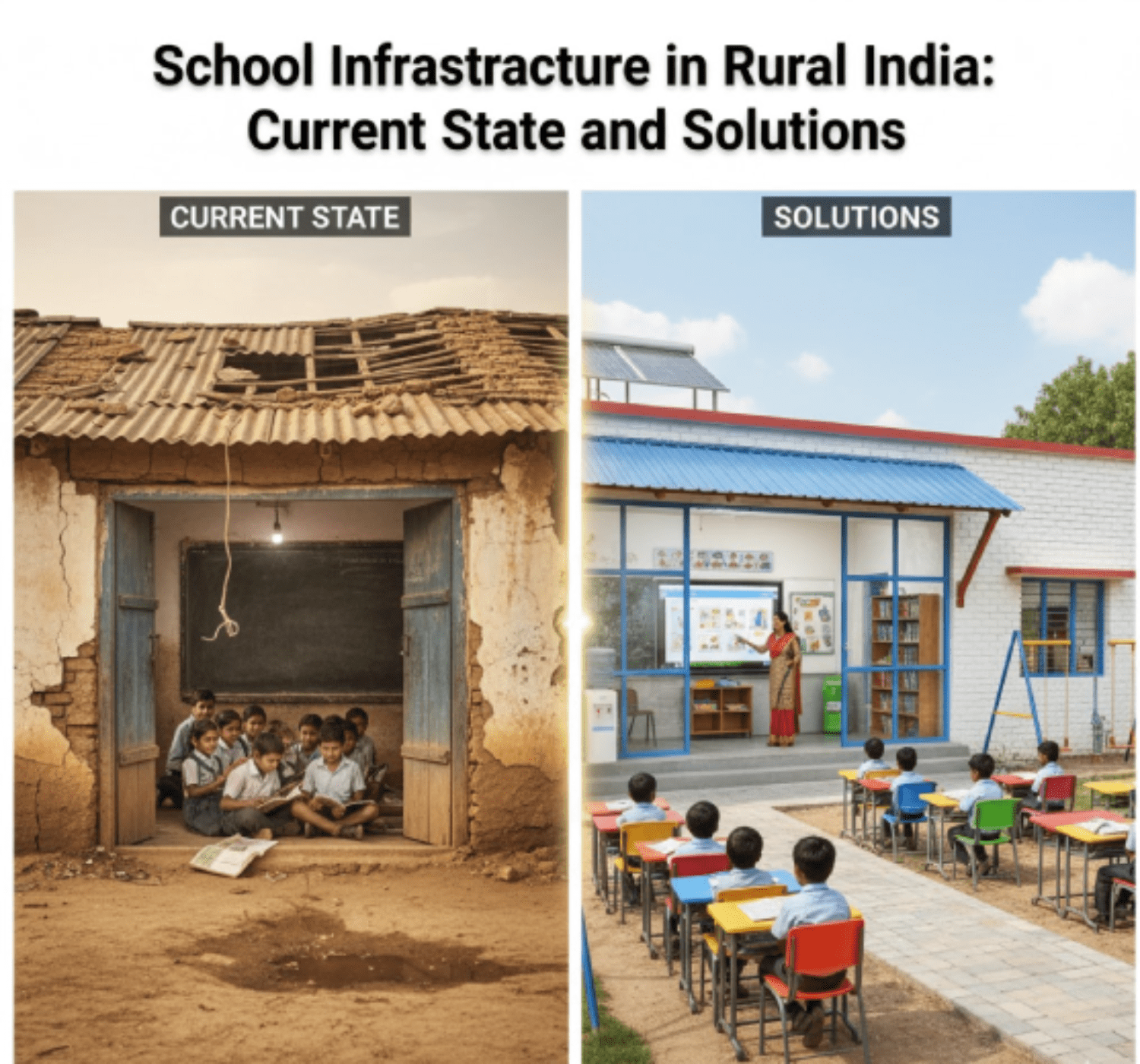India’s education system is often described in terms of policies, reforms, and technological advancements. Rural school infrastructure India is one factor that affects learning. Schools without toilets or classrooms without roofs directly impact learningInfrastructure is more than cement and bricks . It is the foundation upon which millions of rural children’s dreams rest
This article examines the current status of rural school infrastructure.It highlights the gaps in school building conditions and suggests practical solutions for school development needs.
Current State of Rural School Infrastructure in India
India has made significant investments in education over the past two decades.The government has increased enrollment rates through schemes such as Sarva Shiksha Abhiyan and Samagra Shiksha Abhiyan. However, infrastructure remains unevenly distributed. Some schools have upgraded classrooms and digital laboratories, but many still lack the basic facilities rural schools need, such as safe drinking water, toilets with electricity, and appropriate flooring.
The Ministry of Education has revealed that more than 30 percent of schools in some states are in poor school building conditions. This makes it difficult for students to learn in an environment where they feel safe and motivated. The education infrastructure problems that rural India faces are highlighted by the lack of libraries and overcrowded classes, as well as leaking roofs during the monsoon season.
School Building Conditions: Ground Reality
The state of the school buildings speaks volumes about neglect and inequality. In rural areas, temporary classrooms constructed with tin or mud are still common. There are many schools that do not have boundary fences, exposing children to danger.
School building conditions have a direct impact on attendance and dropout rates. Children in classrooms that are poorly constructed often miss class during the harsh summer or when it rains heavily. When the infrastructure is not adequate, teachers also find it hard to teach. In rural education, improving structural stability, ventilation, and space are among the most urgent school development needs in rural education
Basic Facilities Rural Schools Should Provide
Infrastructure is not just the classroom. It is an ecosystem of facilities which facilitates effective teaching and learning. The following are some of the most important basic infrastructure rural schools should have:
- Toilets that work for both girls and boys. Lack of sanitation is a major factor in the higher dropout rates for girls.
- Rural schools are concerned about the safety of drinking water. Many rural schools rely on hand-pump systems or don’t have clean water available at all.
- Electricity and Lighting: Without electricity, digital education or simple evening study sessions are impossible.
- Playgrounds and activity zones – Recreational activities are essential to physical and mental development.
- Children’s curiosity and practical skills are developed in libraries and laboratories.
Education Infrastructure Problems: Holding back Progress
In rural areas,education infrastructure problems persist despite policy initiatives. Inadequate funding, delays in implementation, and a lack of community participation are the main causes for many issues. The situation is made worse by teacher absenteeism, high student-to-teacher ratios, and teacher absences.
Some states have space problems, and schools are forced to share buildings or operate multiple shifts within the same facility. Rural children are also unable to compete in a world increasingly dominated by technology because of a lack of digital infrastructure. These gaps highlight the urgent school development needs that must be addressed to prevent further inequality.
Community participation and local solutions
Participation of the community is a powerful tool to overcome challenges in rural school infrastructure India. Villagers and local panchayats can play an important role in maintaining and upgrading buildings and facilities. The success stories of Kerala and Himachal Pradesh show that when communities are involved, school building conditions significantly improve.
Smaller interventions, such as rainwater harvesting or low-cost digital classes, can help transform the basic facilities rural schools need. These examples show how ground-level projects, combined with government assistance, can have a long-term effect.
Policy Measures to Strengthen Infrastructure
Government intervention remains crucial. It is not enough to fund the construction, but policies must also include maintenance and monitoring. By strengthening schemes under the Samagrashiksha Abhiyan and encouraging private partnerships as well as ensuring that every rupee spent is transparent, education infrastructure problems can be addressed more effectively.
Sustainability is also a key issue in policy. Solar power, energy-efficient materials, and designs that use solar power can help reduce costs in rural areas and promote long-term infrastructure development. Only by aligning policies to school development needs can rural children feel included.
The Road Ahead
India must prioritize school development needs in both terms of size and depth. Not only should we build new classrooms, but also ensure that the infrastructure is safe. It is important to create a child-friendly environment where learning can be inspiring and not burdensome.
By upgrading school building conditions and providing clean drinking water, modern sanitation, as well as digital tools, the rural-urban divide could be bridged. The investments we make today will determine if future generations see education as a right or continue to struggle against physical barriers to learning.
Conclusion
Rural school infrastructure in India is at a crossroads.. The condition of School conditions reflect deep inequalities, despite increased access to education. Poor school building conditions and the lack of basic facilities rural schools should have threaten to undermine progress.
However, solutions exist.India can meet its urgent school development needs through stronger policies, community involvement, and sustained investment.This requires not grandiose promises but concrete action to make classrooms safe, inspiring, and inclusive
FAQS
1. What is the state of rural education infrastructure in India today?
In state of rural school infrastructure in India is not uniform. Some schools have upgraded their facilities but many lack electricity, safe classrooms and sanitation. This creates barriers to learning.
2. Why is it important to have school buildings in rural areas?
School Building conditions have a direct impact on attendance, safety, and learning outcomes. When it rains or is hot, poorly constructed classrooms can disrupt the lessons. This discourages children from regularly attending.
3. What are the basic needs of rural schools?
Basic facilities rural schools must have clean toilets, drinking water that is safe, electricity, laboratories, playgrounds, and libraries. They are essential for equal educational opportunities.
4.How can education infrastructure problems in rural schools be solved?
Education Infrastructure Problems Can be Solved through Stronger Policies, Local Community Participation, and Targeted Investments Focused on School Development Needs. This will ensure that facilities are functional and inclusive.

